Life
He was the son of Hugh III and succeeded his father as count of Maine. [lower-alpha 1] Herbert was, at times, a nominal vassal of his neighbor Fulk III Nerra, Count of Anjou but otherwise considered himself independent [2] and obtained his nickname "Wake-dog" for having to constantly resist the intrusions of his Angevin neighbors to the south. [3] From the time Herbert became count in 1017, he was almost constantly at war with Avesgaud de Bellême, Bishop of Le Mans. [4]
In 1016, a young Herbert was allied to Fulk III in a war against Odo II of Blois. On 6 July, Odo was en route to attack the fortress of Montrichard. Upon discovering this, Fulk and Herbert split their forces to block either of the two approaches. [5] Odo ran headlong into the Angevin force under Fulk, known as the Battle of Pontlevoy. [6] Odo’s greater force was prevailing and Fulk himself was thrown from his horse and in danger of being killed or captured, but a messenger had been sent to Herbert to come immediately.
Herbert attacked the left flank of Odo’s forces throwing them into complete confusion; Odo’s mounted force fled leaving his foot soldiers to be slaughtered. [7] Odo was defeated [5] and was unable to challenge Fulk again for nearly a decade. [7] While this battle established Herbert’s reputation as a warrior it also began deteriorating the relationship between Fulk and Herbert. [8]

His battles with Avesgaud, Bishop of Le Mans, were heating up again and, in 1025, Herbert made a night raid on the Bishop’s castle at Duneau causing Avesgaud to flee to the protection of his brother William Lord of Belleme. Once he was safe, the Bishop excommunicated Herbert and then continued his warring against him. [9] Not long after the excommunication was lifted and peace was restored between them, Herbert started raiding the Bishop's estates again. This time, Herbert, with the help of Count Alan III of Rennes, attacked the Bishop at his castle at Le Ferte and reduced this castle as well. [10]
On 7 March 1025, Fulk Nerra lured Herbert to Saintes on the promise of giving him Saintes as a benefice. [11] Herbert was captured and imprisoned for two years until a coalition forced his release. [11] During his captivity Fulk had taken over the government of Maine and before returning Herbert to his countship, he seized the southwestern territories of Maine including several fortresses, attaching them to Anjou. [12] It was only after suffering complete humiliation that Herbert was allowed to go free. [13]
Due in part to his wars with Bishop Avesguadus (an ally of Fulk Nerra) and in part with his imprisonment, the county of Maine declined under Herbert I. [14] He built the castle of Sablé but by 1015 he had for some reason allowed it to become an independent lordship under the viscounts of Maine. Likewise, Chateau-du-Loir built in the early eleventh century also quickly came under control of independent castellans. [14]
While plain coins with only Latin motto Gratia dei rex had been minted under comital authority throughout the tenth century at Le Mans, at some time between 1020 and 1030 coins were struck with the monogram of Count Herbert and the motto signum Dei vivi and continued with this design through the twelfth century. The coins at Le Mans were of such weight and fine quality they were among the most widely accepted in western France. [15] Herbert died on 13 April 1035. [16]










